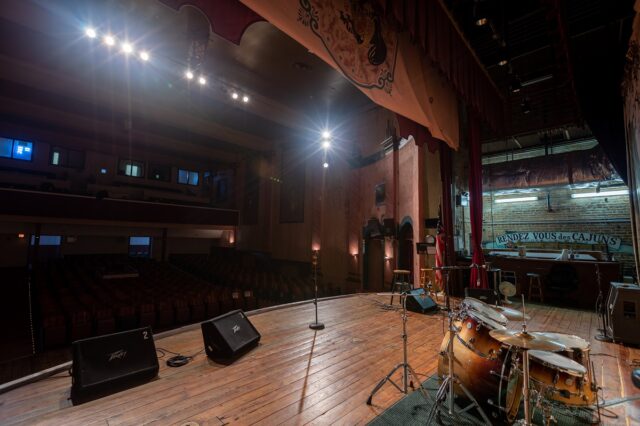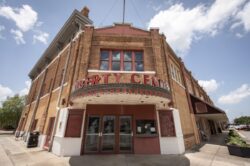The Liberty Theatre
Acadiana’s “Temple of Amusement”
Published: September 1, 2020
Last Updated: March 22, 2023
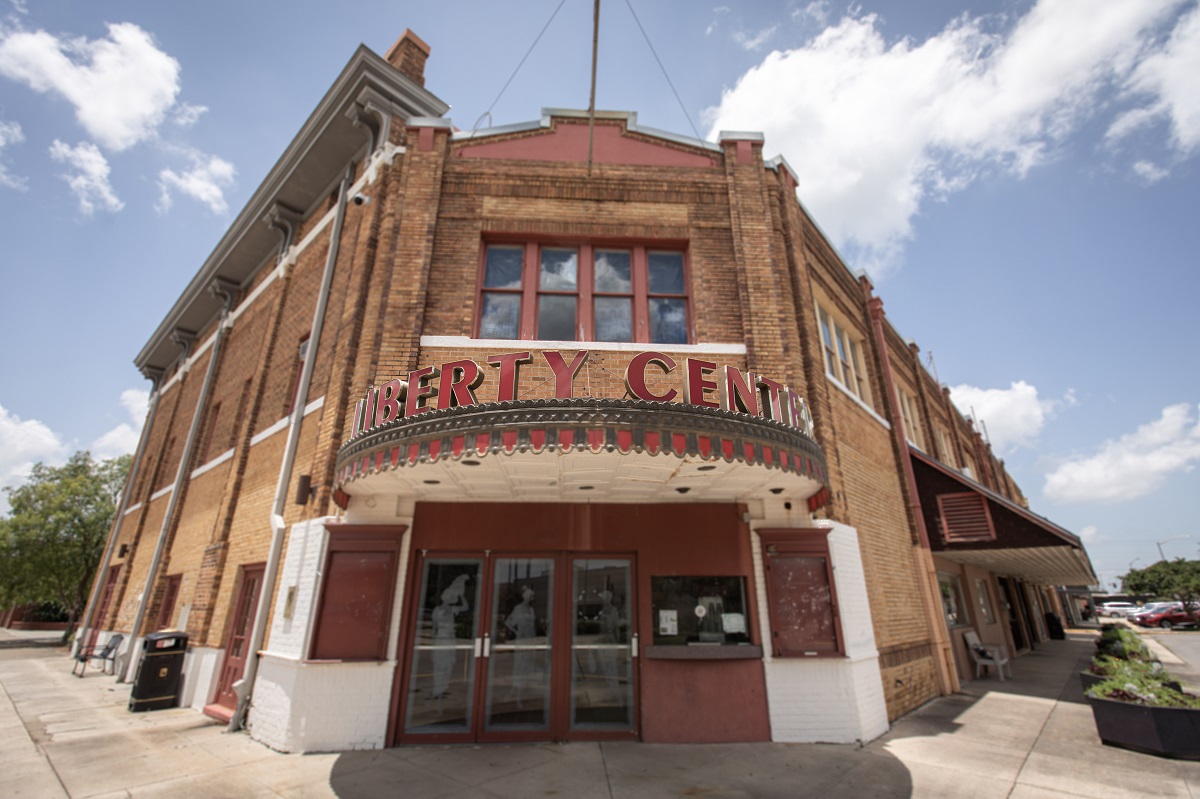
Photo by Brian Pavlich
Construction for the two-story brick building that became the Liberty Theatre began in 1919. Work ceased due to the financial crisis of 1920 that devolved into the short depression of 1921, leaving only the exterior near completion. In the spring of 1924, construction resumed in a rush to meet the New Liberty Theatre’s July opening date. “The theatre will move up in the front ranks of the larger theatres of the state,” the New Era newspaper predicted. “Now, as we plunge into a description of this modern theatre, take into consideration the value of such an amusement rendez-vous for a town of this size.” In addition to movies, Liberty manager Keller, a fourteen-year veteran of the theatrical business, promised a winter season including opera, musical comedies, and “high-class” vaudeville.
The New Liberty Theatre opened on Saturday, July 19, 1924. The theatre’s ad in the New Era proclaimed it “the biggest thing in southwest Louisiana,” boasting that the forty-two-thousand-square-foot building required thirty-five carts of bricks and eighteen months of construction to complete, at a cost of $110,000. The partially towering structure at Park Avenue and Second Street soon earned its title as the region’s “Premier Temple of Amusement.”
Opening day at the Liberty began with a free screening of an Our Gang comedy for children. Lilies of the Field, a melodrama about an unfaithful husband who accuses his innocent wife of infidelity, screened that afternoon. Upcoming attractions included The Eternal Three, billed as “a powerful drama of a man who made beautiful women his prey,” and the likewise torrid Scars of Jealousy.
The New Liberty Theatre—designated “new” because two previous Liberty theatres had operated in Eunice—featured one thousand seats as well as electrical fixtures, a “typhoon cooling” system, and steam heat. In the event of a fire on the stage, the auditorium’s nonflammable curtain could be dropped, therefore saving the remainder of the building, not to mention the audience. The stage, measuring fifty-two feet high, forty feet wide and twenty-five feet deep, could accommodate “any road show touring as far south as New Orleans,” the New Era reported. The theatre’s attributes also included restrooms for men and women featuring “running ice water” and “a large balcony, one side of the latter for whites and the other side for colored.”
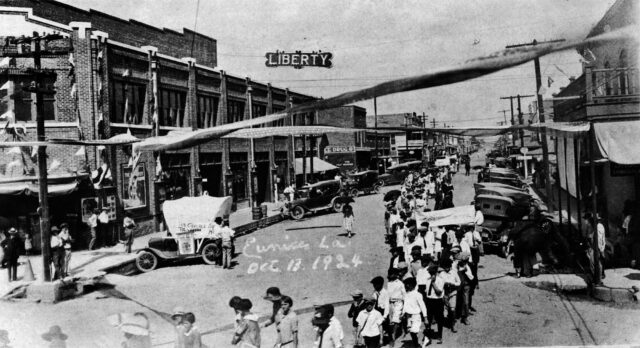
The Liberty Theatre has been a downtown fixture for decades, as seen in this 1924 shot of residents lined up to see a silent Western, The Covered Wagon. Photo by Bevan Brothers Photography, Harris Images.
On March 3, 1929, the Liberty screened the first talking picture exhibited in Eunice. Ten cents’ admission bought patrons vaudeville and musical performances and a screening of The Bellamy Trial, a crime drama in which a Long Island society woman’s husband, ex-boyfriend, and romantic rival are suspects in her mysterious death. The murals on the theatre’s walls—depicting women in a contemporary and classical vein—were painted in the early 1930s by an artist known only as “old man Zelman.”
Keller proved a showman. His promotions included the installation of a log cabin façade for 1935’s Call of the Wild, starring Clark Gable and Loretta Young, and a high-wire act above Second Street. The Liberty operated as a family business, and the box office staff included Keller’s wife, Regina Guillory Keller, and the couple’s daughters. Following Keller’s death in 1951, the Keller family continued operating the Liberty and its sister theatres the Queen (opened 1937) and K&B (1946). When the Eunice News profiled the Liberty Theatre Company in 1952 for its twenty-eighth anniversary, J. Claude and Regina Kellers’ children, Rosemary Herrod and J. C. Keller Jr., were co-managing the business. By 1982, the Liberty, like thousands of single-screen downtown movie theatres across the United States, had closed. It ended its nearly fifty-eight years as a movie theatre with The Cannonball Run, starring Burt Reynolds, on January 3, 1982.
Liberty Reborn
The cultural stirrings that spurred the reopening of the Liberty Theatre later that year began nearly twenty years earlier. In 1964, Dewey Balfa, Gladius Thibodeaux, and Louis “Venesse” Lejeune became the first Cajun musicians to perform at the Newport Folk Festival. For an audience that had come to hear Bob Dylan, Peter, Paul, & Mary, and Joan Baez, the Cajun band proved a revelation. “I had played in house dances,” Cajun fiddler Balfa said later, “family gatherings, maybe a dance hall where you might have seen as many as two hundred people at once. In fact, I doubt I had ever seen two hundred people at once. And in Newport, there were seventeen thousand. Seventeen thousand people who wouldn’t let us get off stage.”
In succeeding years, more Cajun and Creole performers were enthusiastically received at Newport. Southwest Louisiana’s indigenous music became a staple of folk festivals throughout the world. Meanwhile, Marc Savoy, a Cajun musician and accordion maker, lamented that the music wasn’t appreciated in Eunice and Acadiana. “I told everybody,” he remembered, “there’s all this amazing culture that’s alive here, but then we travel eighteen hundred miles from Louisiana to come to a folk festival, because there are no festivals in our area.”
In 1980, after Savoy participated in folk festivals at national parks throughout the United States, he helped organize the Society for the Preservation of Ethnic Culture in Acadian Louisiana, a.k.a. SPECIAL. In 1982, Savoy and his SPECIAL friends cleaned and repaired the Liberty Theatre so the organization could present Santiago Jiménez, a Tex-Mex musician from San Antonio, in concert there.
“A couple of guys could fix anything,” Savoy said. “Some others were good plumbers and electricians. We fixed the toilets and the lights. I’m sure we were drinking beer, but we made it workable for this concert. We couldn’t go to a bar or a dancehall because this music wouldn’t interest people who went to Cajun dances. We had to find someplace else. There was this funky old theatre built in my father’s day. He told me about his time at the vaudevilles.” Savoy also knew the Liberty from his own childhood. In the late 1940s and early 1950s, he attended movies there when his father hauled rice to the mill across the railroad tracks from the theatre. “Nine cents for a whole afternoon of movies,” he said.
SPECIAL’s Jiménez concert and the subsequent Liberty screening of folklorist Nick Spitzer’s documentary, Zydeco, were successful. Savoy told Spitzer about his dream of establishing a national park in Eunice that would showcase Cajun and Creole culture. Spitzer put Savoy in touch with Jim Isenogle, superintendent of the Jean Lafitte National Historical Park in New Orleans. After Isenogle suggested the Liberty Theatre was the ideal companion for a national park, Savoy approached Eunice’s mayor, Curtis Joubert, about the city buying the property. Joubert happened to be a French-speaking Cajun who loved Cajun music. And like generations of people in Acadia and St. Landry Parishes, he’d watched cliffhanger serials at the Liberty on Saturday afternoons in an auditorium packed with Cajun country kids. “I thought it was fantastic,” Joubert said of Savoy’s national park idea. “Because we had this old empty theatre right across the street [from the mayor’s office]. And we had all these legendary musicians around here, but all they used to do was go play overseas and then come back and put their fiddles and guitars and accordions under the bed. We came up with the idea of putting them on the [Liberty] stage.”
Eunice purchased the Liberty Theatre in 1986. “Curtis took my idea and ran with the ball,” Marc Savoy said. Savoy’s wife and fellow musician, Ann Allen Savoy, curated a series of venue-testing shows, including reenactments of a fais do-do (Cajun house dance), an Acadian wedding, and an old-time radio show. The shows included classic Cajun musicians Dennis McGee, Sady Courville, Aldus Roger, and the Hackberry Ramblers. Although the Park Service’s Prairie Acadian Cultural Center, part of the Jean Lafitte National Historical Park and Preserve, wouldn’t open in Eunice until 1991, the Rendez-vous des Cajuns show at the Liberty Theatre debuted on July 11, 1987.
Ann Savoy booked the first fifteen years of weekly Saturday night performances. In its original conception, Rendez-vous des Cajuns was a Cajun-French hybrid of Nashville’s Grand Ole Opry, Shreveport’s Louisiana Hayride, and Garrison Keillor’s A Prairie Home Companion. A typical show featured a Cajun band, a zydeco or Creole band, and a cultural segment featuring a humorist, recipe, or craftsperson. “It was super fun to have that wealth of working musicians to draw upon,” Savoy said. “Because the show was new and a big deal then, everybody wanted to play.”
“I’m so glad that they saved the theatre,” said Liberty performer Michael Doucet, leader of the Grammy Award–winning BeauSoleil. “That was the main thing, because there are so few of them left. A lot of them are parking lots, which probably the Liberty would have been, too.”
Barry Jean Ancelet, a professor of francophone studies at the University of Louisiana at Lafayette, emceed Rendez-vous des Cajuns through its first twenty-four years. “It was a showcase, a statement about who we are,” Ancelet explained. “And because it was attached to the National Park Service, it didn’t present us as a caricature or a tourist brochure. It was important to tell them our story ourselves.”
At first, Ancelet clashed with Ann Belkov, the new superintendent of the Jean Lafitte National Historical Park and Preserve, over whether the show should be in French or English. A few weeks after he performed the first Rendez-vous des Cajuns show in French, the issue came up at a meeting whose attendees included Dewey Balfa. “A sage, a philosopher,” Ancelet said of Balfa. “At the meeting, Ann Belkov said, ‘This has to be English, because this is for Americans.’ Dewey said, ‘Ma’am, we are Americans.’ He went on to say that this weekly show in Eunice is one of the only indications he had that the tax dollars he paid year after year were coming back to him in anything but bombs and interstates. You could have heard a pin drop. It hit home that Americans are not only English speakers. To her credit, Ann Belkov realized the wisdom of this.”
The Rendez-vous des Cajuns program quickly found an audience of locals and tourists. Eunice’s mayor remained a big supporter. “Curtis Joubert was there every night to greet the people,” Ann Savoy said. “And the mayors after him always were there to greet people. It was something dear to their hearts.”
“It took off and people from all over the world came,” Joubert said. “We were proud to host it. Besides that, it brought business to our little community. People would listen to music and then go to all of the restaurants.”
The Liberty itself is an important part of Rendez-vous des Cajuns, Ancelet said. “It wasn’t a smoky dancehall. It was a lovely, big environment with seating. People listened to the music in a way that they didn’t often do. And the fact that the building is historic, people felt like they were coming back to vaudeville days; but it also was modern. Young kids were playing up there. And kids in the audience saw their moms and dads and grandparents and aunts and uncles enjoying it. It showed them the value in their own culture.”
The Rendez-vous des Cajuns shows at the Liberty continued until the coronavirus pandemic prompted a ban on large public gatherings in March 2020. By summer, issues with the theatre’s heating, ventilation, and air-conditioning system would have stopped the show anyway. The city of Eunice plans to replace the HVAC system, Mayor Scott Fontenot said, reopen the Liberty Theatre, and revive Rendez-vous des Cajuns as soon as possible. Joubert, the eighty-nine-year-old former major of Eunice, is looking forward to another Liberty Theatre era. “Don’t think we don’t miss that Saturday-night packed house, with people going to the restaurants in our little town, shopping, and just coming to Eunice,” he said.
John Wirt is the author of the New Orleans music biography Huey “Piano” Smith and the Rocking Pneumonia Blues.
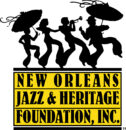 This article is funded in part by a grant from the New Orleans Jazz & Heritage Foundation.
This article is funded in part by a grant from the New Orleans Jazz & Heritage Foundation.
